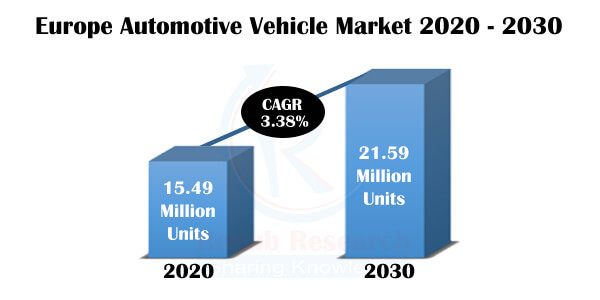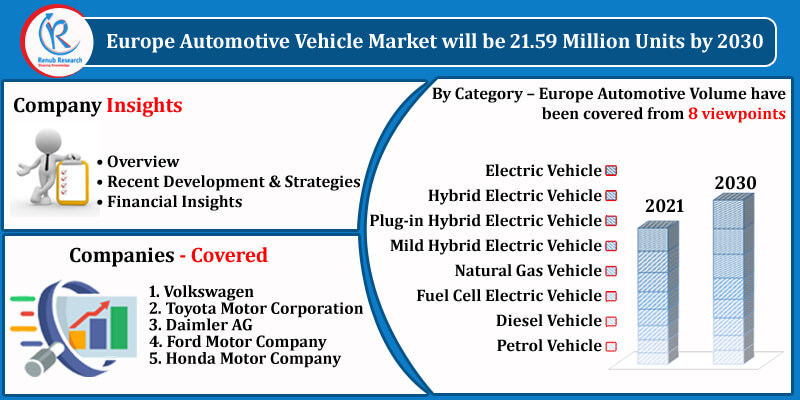Europe Automotive Vehicle Market Forecast 2021-2030, Share, Insight, Growth, Impact of COVID-19, Opportunity Company Analysis
Buy NowEurope Automotive Vehicle Market Outlook
The European automotive industry has been booming and has become a global leader and driver of Europe's growth and prosperity. In recent years, the European automobile sector has ascended to the top of the worldwide industry. Moreover, the European automotive industry has achieved record sales and is a significant employer and a source of considerable grant making in European society. According to Renub Research, European Automotive Vehicle Market is expected to reach 21.59 Million Units by 2030.

Notwithstanding, the automotive industry has brought Europe freedom and access from mobility while making it increasingly time-efficient, safer, and more affordable. The automotive sector also contributes to environmental welfare. At the same time, the industry is thriving in keeping the disturbing impact on the environment of the steep hike in numbers of cars on the road in check, mainly through effective emission reductions. Also, the automotive sector seems to be a strong industry with attractive job opportunities and a growth engine of Europe's economy. Hence, the industry is economically robust but with a clear gap to highly profitable sectors.
Mild Hybrid Vehicle is expected to provide Significant Growth over the Next Decade in European Automobile Industry
Furthermore, the European automotive industry is uniquely situated to become a centre for developing, testing, and eventually adopting new mobility technologies. By Category, the European automobile industry's principal categories include Electric Vehicle (EV), Hybrid Electric Vehicle (HEV), Plug-in Hybrid Electric Vehicle (PHEV), Mild Hybrid Vehicle (MHEV), Natural Gas Vehicle (NGV), Fuel Cell Electric Vehicle (FCEV), Diesel Vehicle and Petrol Vehicle. The MHEV market is dominant, increasing, and expected to provide significant growth over the next decade. In Europe, PHEVs are expected to almost completely replace pure internal combustion engine (ICE) vehicles in the future. Moreover, MHEVs will play a significant role in a balanced powertrain portfolio for the next decade.
Europe Automobile Market Size is expected to grow with a CAGR of 3.38% from 2020 to 2030
Remarkably, the regions and players in the conventional automotive set are also obtaining momentum, and a growing wave of technological megatrends is redefining versatility. Even the core competencies for future prosperity are changing rapidly. In the coming years, European automotive players will require to develop these competencies and manage an employment transition to sustain their position at the vanguard of the industry.
In addition, the Europe automobile sector is expected to stay ahead in the changing competitive landscape, and therefore leaders will need to make some complex decisions. Above all, a shared vision concerning the European automotive sector's positioning is necessary as well. The automotive passenger vehicles as a cornerstone for individual mobility and the commercial, automotive vehicle as the backbone of the European economy contribute tremendously to society, environment, economic welfare, and growth in Europe.
Coronavirus devastating effect on European Automotive Vehicle Industry
European car markets are gracing to deceive as sales promotions look good but only when contrasted with 2020, smashed by the shock of coronavirus shutdowns and short-term economic disaster. Our analysis expects a solid recovery as the year progresses and coronavirus vaccinations become ubiquitous. At the same time, apprehensions about the impact of the coming wave of Covid infections and a chip shortage remain in the background until the world is ultimately set free from the virus.
Europe Automotive Market was 15.49 Million Units in 2020
As per our analysis, over the following years and decades, the automotive industry will undergo a disruptive transformation towards a mobility industry. Many forces within and from outside the industry will try to transform the sector. The automotive ecosystem will open up, new players will enter, and industry boundaries will become fluid or disappear. In other words, we are going to see a global industry reshuffle.

The Europe Automotive Vehicles Market is consolidated with several international players. The major players are Volkswagen, Toyota Motor Corporation, Daimler AG, Ford Motor Company and Honda Motor Company. These players make joint ventures, partnerships and launch new products with advanced technology to dominate their competitors. For instance, in 2020, Toyota launched KINTO, a single brand for mobility services in Europe. Similarly, in 2021, Ford announced a new strategy to go all-electric in Europe by 2030.
Renub Research latest report titled "Europe Automotive Vehicle Market, By Category (EV Volume, HEV Volume, PHEV Volume, MHEV Volume, NGV Volume, FCEV Volume, Diesel Volume and Petrol Volume), Company (Volkswagen, Toyota Motor Corporation, Daimler AG, Ford Motor Company and Honda Motor Company)" provides a detailed analysis of Europe Automotive Vehicle Market
By Category – Europe Automotive Volume have been covered from 8 viewpoints:
1. Electric Vehicle (EV)
2. Hybrid Electric Vehicle (HEV)
3. Plug-in Hybrid Electric Vehicle (PHEV)
4. Mild Hybrid Electric Vehicle (MHEV)
5. Natural Gas Vehicle (NGV)
6. Fuel Cell Electric Vehicle (FCEV)
7. Diesel Vehicle
8. Petrol Vehicle
Company Insights:
• Overview
• Recent Development & Strategies
• Financial Insights
Company Analysis:
1. Volkswagen
2. Toyota Motor Corporation
3. Daimler AG
4. Ford Motor Company
5. Honda Motor Company
Report Details:
| Report Features | Details |
| Base Year | 2020 |
| Historical Period | 2017 - 2020 |
| Forecast Period | 2021-2030 |
| Market | Million Units |
| Segment Covered | Category |
| Category Covered | Electric Vehicle (EV) Volume, Hybrid Electric Vehicle (HEV) Volume, Plug-in Hybrid Electric Vehicle (PHEV) Volume, Mild Hybrid Electric Vehicle (MHEV) Volume, Natural Gas Vehicle (NGV) Volume, Fuel Cell Electric Vehicle (FCEV) Volume, Diesel Vehicle Volume, Petrol Vehicle Volume |
| Companies Covered | Volkswagen, Toyota Motor Corporation, Daimler AG, Ford Motor Company, Honda Motor Company |
| Customization Scope | 20% Free Customization |
| Post-Sale Analyst Support | 1 Year (52 Weeks) |
| Delivery Format | PDF and Excel through Email (We can also provide the editable version of the report in PPT/Word format on request) |
1. Introduction
2. Research Methodology
3. Executive Summary
4. Market Dynamics
4.1 Growth Drivers
4.2 Challenges
5. Europe Automotive Market
6. Volume Share
6.1 By Categories
7. Category – Europe Automotive Volume
7.1 Electric Vehicle (EV) Volume
7.2 Hybrid Electric Vehicle (HEV) Volume
7.3 Plug-in Hybrid Electric Vehicle (PHEV) Volume
7.4 Mild Hybrid Vehicle (MHEV) Volume
7.5 Natural Gas Vehicle (NGV) Volume
7.6 Fuel Cell Electric Vehicle (FCEV) Volume
7.7 Diesel Vehicle Volume
7.8 Petrol Vehicle Volume
8. Company Analysis
8.1 Volkswagen
8.1.1 Overview
8.1.2 Recent Development
8.1.3 Financial Insights
8.2 Toyota Motor Corporation
8.2.1 Overview
8.2.2 Recent Development
8.2.3 Financial Insights
8.3 Daimler AG
8.3.1 Overview
8.3.2 Recent Development
8.3.3 Financial Insights
8.4 Ford Motor Company
8.4.1 Overview
8.4.2 Recent Development
8.4.3 Financial Insights
8.5 Honda Motor Company
8.5.1 Overview
8.5.2 Recent Development
8.5.3 Financial Insights
List Of Tables:
Figure-01: Europe Automotive Volume (Million Units), 2017 – 2020
Figure-02: Forecast for – Europe Automotive Volume (Million Units), 2021 – 2030
Figure-03: Category – EV Volume (Thousand Units), 2017 – 2020
Figure-04: Category – Forecast for EV Volume (Thousand Units), 2021 – 2030
Figure-05: Category – HEV Volume (Thousand Units), 2017 – 2020
Figure-06: Category – Forecast for HEV Volume (Thousand Units), 2021 – 2030
Figure-07: Category – PHEV Volume (Thousand Units), 2017 – 2020
Figure-08: Category – Forecast for PHEV Volume (Thousand Units), 2021 – 2030
Figure-09: Category – MHEV Volume (Thousand Units), 2017 – 2020
Figure-10: Category – Forecast for MHEV Volume (Thousand Units), 2021 – 2030
Figure-11: Category – NGV Volume (Thousand Units), 2017 – 2020
Figure-12: Category – Forecast for NGV Volume (Thousand Units), 2021 – 2030
Figure-13: Category – FCEV Volume (Thousand Units), 2017 – 2020
Figure-14: Category – Forecast for FCEV Volume (Thousand Units), 2021 – 2030
Figure-15: Category – Diesel Vehicle Volume (Thousand Units), 2017 – 2020
Figure-16: Category – Forecast for Diesel Vehicle Volume (Thousand Units), 2021 – 2030
Figure-17: Category – Petrol Vehicle Volume (Thousand Units), 2017 – 2020
Figure-18: Category – Forecast for Petrol Vehicle Volume (Thousand Units), 2021 – 2030
Figure-19: Volkswagen – Global Revenue (Billion US$), 2017 – 2020
Figure-20: Volkswagen – Forecast for Global Revenue (Billion US$), 2021 – 2030
Figure-21: Toyota Motor Corporation – Global Revenue (Billion US$), 2017 – 2020
Figure-22: Toyota Motor Corporation – Forecast for Global Revenue (Billion US$), 2021 – 2030
Figure-23: Daimler AG – Global Revenue (Billion US$), 2017 – 2020
Figure-24: Daimler AG – Forecast for Global Revenue (Billion US$), 2021 – 2030
Figure-25: Ford Motor Company – Global Revenue (Billion US$), 2017 – 2020
Figure-26: Ford Motor Company – Forecast for Global Revenue (Billion US$), 2021 – 2030
Figure-27: Honda Motor Company – Global Revenue (Billion US$), 2017 – 2020
Figure-28: Honda Motor Company – Forecast for Global Revenue (Billion US$), 2021 – 2030
List Of Tables:
Table-01: Europe Automotive Volume Share by Category (Percent), 2017 – 2020
Table-02: Forecast for – Europe Automotive Volume Share by Category (Percent), 2021 – 2030
Reach out to us
Call us on
USA: +1-478-202-3244
INDIA: +91-120-421-9822
Drop us an email at
info@renub.com